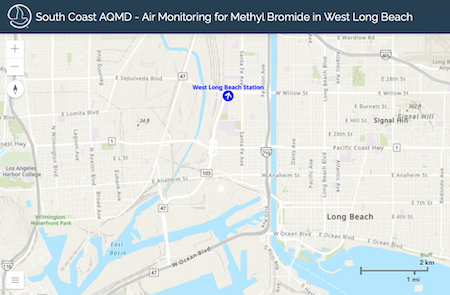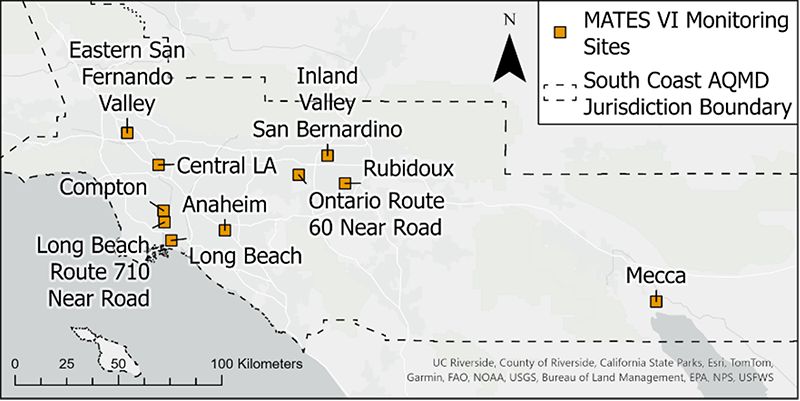RECENT ACTIVITY
South Coast AQMD Public Meeting - March 20, 2025: View Presentation
View Meeting Recording
OVERVIEW
In response to community concerns the California Air Resources Board (CARB) began conducting air monitoring for MeBr in the West Long Beach area near multiple fumigation facilities in 2023. CARB’s monitoring efforts detected higher levels of MeBr in the West Long Beach area with peaks occurring during the spring months and identified two fumigation facilities as the potential source of these emissions.
South Coast AQMD is taking action to evaluate impacts from all fumigation facilities in our jurisdiction, including:
- Working with CARB on air monitoring efforts at or near identified fumigation facilities.
- Obtaining fumigant usage data from facilities, conducting initial health screening analyses, and imposing additional reporting requirements under the Air Toxics Hotspots program for facilities identified as potentially having off-site health impacts.
- Working with the Los Angeles County Agricultural Commissioner to evaluate near term actions that could be included in permit conditions.
ABOUT FUMIGATION FACILITIES AND FUMIGANTS
Fumigation of various items such as fruits, vegetables, or other products is conducted near ports for pest control before and after shipping to or from other countries. Fumigants used at these facilities include MeBr, Aluminum Phosphide, Magnesium Phosphide, and Sulfuryl Fluoride. Fumigant usages are regulated by the Department of Pesticide Regulation and permitted by the county Agricultural Commissioners.
HEALTH IMPACTS
Exposure to fumigants at levels above health standards may cause non-cancer health effects. Non-cancer health effects are not expected when pollutant levels are below health-based reference levels. Current information indicates that MeBr is the most common fumigant used at fumigation facilities. Potential non-cancer health effects from MeBr can include impacts to the respiratory, developmental, nervous, cardiovascular, and gastrointestinal systems.
The California Office of Environmental Health Hazard Assessment (OEHHA) establishes health risks from environmental contaminants. OEHHA has established a short-term (acute) reference exposure limit (REL) for MeBr at 1,000 parts per billion (ppb). The short- term REL is the maximum amount of a chemical a person can safely breathe for a short period of time, usually an hour, without experiencing harmful health effects.
PREVIOUS AIR MONITORING
In response to community concerns, CARB initiated a monitoring campaign for MeBr in early 2023. CARB’s monitoring data is available for viewing here. Monitoring efforts were transitioned over to South Coast AQMD on May 21, 2025.
CURRENT MONITORING
South Coast AQMD is conducting continuous monitoring of MeBr at a site located near the intersection of the Terminal Island Fwy and W Willow St in West Long Beach. This location was chosen because it is downwind of two fumigation facilities. The site measures MeBr hourly and results will be available daily via the data dashboard below.
During the air monitoring transition from CARB to South Coast AQMD, a sampler was installed and calibrated. In order to fill in the monitoring gap and ensure correct calibration of the monitor, South Coast AQMD collected 24-hour integrated (midnight-to-midnight) air samples of MeBr every three days. Results from that short-term air sampling can be found here.
Click on the map below to be transferred to the data dashboard
MULTIPLE AIR TOXICS EXPOSURE STUDY
The Multiple Air Toxics Exposure Study (MATES) is a monitoring and evaluation study conducted in the South Coast Air Basin (Basin) that focuses on the carcinogenic risk from exposure to air toxics.
Between 2018 to 2019 South Coast AQMD monitored over 100 toxic pollutants at 10 different locations throughout the region as part of our MATES V study. MeBr was detected in the West Long Beach area above background levels, but below health-based reference levels. The next closest MATES V monitor located about three miles to the east showed MeBr closer to background levels.
South Coast AQMD is evaluating potential next steps for additional monitoring in relation to fumigation facilities within our jurisdiction. Currently, South Coast AQMD is preparing to begin monitoring in July 2025 for the MATES VI study, which will include MeBr monitoring at 10 locations throughout the region. The primary purpose of this monitoring is to evaluate regional trends in toxic pollution and is not designed to focus on specific sources (see map below). Two of the 10 MATES VI monitoring locations will be located in Long Beach, one in Signal Hill and another along the 710 freeway.

AIR TOXICS HOT SPOTS PROGRAM
AB 2588 is a state program that collects emissions data from facilities and assess potential health impacts. South Coast AQMD’s Air Toxics Hot Spot Program (Rule 1402), is designed to provide information to the public about toxic air emissions and potential health risks from a facility. Under this program, facilities may be required to control and reduce health risks if they exceed certain thresholds. Facilities may be required to conduct Health Risk Assessments and develop and implement actions to lower emissions and reduce risks.
Currently six facilities were required to provide comprehensive reports detailing all air toxics emissions:
- Ag -Fume Services Inc., Long Beach, CA.
- SPF Terminals, Long Beach, CA.
- Global Pest Management Inc., Long Beach, CA
- Global Pest Management Inc., Compton, CA
- Harbor Fumigation Inc., San Pedro, CA
- Ag-Fume Services Inc., San Pedro, CA
South Coast AQMD will review these reports and conduct an additional screening analysis to determine next steps. If there is a potential for offsite health risks above rule thresholds, a full Health Risk Assessment (HRA) will be required that will identify actions to reduce risk. If no HRA is required, a facility may still be required to regularly report their emissions. Once available, emissions data will be displayed on our FIND webpage.
Approved HRAs are made publicly available on our website here. As of March 2025, no fumigation facility has yet been required to prepare a HRA.
PERMITTING
Most fumigation facilities in Los Angeles County are permitted by the L.A. County Agricultural Commissioner. These permitting responsibilities were established under a Memorandum of Understanding (MOU) signed in 1996. Three L.A. County fumigation facilities are permitted by South Coast AQMD under the federal Title V program. Recently the L.A. County Agricultural Commissioner updated permit conditions to reduce exposure from the two facilities in the West Long Beach area (Ag-Fume Services Inc. and SPF Terminals) including:
- No fumigation during school hours
- Increased stack heights to reduce exposure to Methyl Bromide at ground-level
- Coordination of fumigation activities such that both facilities are not releasing fumigants at the same time
- Additional leak prevention measures
- South Coast AQMD and LA County Agricultural Commissioner are also exploring the future role of the existing MOU that specifies each agency’s role with the permit process.
ADDITIONAL RESOURCES
South Coast AQMD AB 2588 Program: https://www.aqmd.gov/home/rules-compliance/compliance/toxic-hot-spots-ab-2588
CARB West Long Beach Methyl Bromide Webpage https://ww2.arb.ca.gov/capp/cst/ch2/wcwlb/methyl-bromide
Los Angeles County Agricultural Commissioner https://acwm.lacounty.gov/pest-control-operators/
CA Department of Pesticide Regulation https://www.cdpr.ca.gov/pesticide-use-in-california/
U.S. Department of Agriculture Animal and Plant Health Inspection Service https://www.aphis.usda.gov/plant-imports/how-to-import
U.S. Environmental Protection Agency https://www.epa.gov/ods-phaseout/methyl-bromide
United Nations Environmental Program – Methyl Bromide https://www.unep.org/ozonaction/what-we-do/methyl-bromide